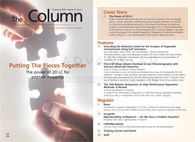The 10th Balaton Symposium on High-Performance Separation Methods: A Review
A review of the 10th Balaton Symposium on High-Performance Separation Methods, which was held 2–4 September 2015 at the Hotel Azúr, Siófok, Hungary.
Photo Credit: Zsolt Hlinka/Getty Images

Ira Krull, Northeastern University, Boston, Massachusetts, USA.
A review of the 10th Balaton Symposium on High-Performance Separation Methods, which was held 2–4 September 2015 at the Hotel Azúr, Siófok, Hungary.
The Hungarian Society for Separation Sciences, headed by Professor Attila Felinger (Department of Analytical and Environmental Chemistry, University of Pécs, Hungary) organized the 10th biennial Balaton Symposium meeting, which was held 2–4 September 2015 at the Hotel Azúr, on the shores of Lake Balaton, Siófok, Hungary. The Diamond Congress of Hungary coordinated the symposium, which included presentations from notable scientists, plenary lectures, and keynote lectures. In addition, awards were presented to student posters that were deemed exceptional.
Technical sessions and poster presentations were combined with a full social agenda including meals with unique entertainment from Zoltán Orosz, a Hungarian accordionist, and a four-piece band and singer. The symposium concluded with an evening buffet-style barbeque by the outdoor hotel pool, complete with drinks.
The biennial conference was attended by 285 scientists, mainly from Europe, but with a few attendees from the USA, Canada, Asia, and Israel. In addition, there was a very successful exhibition comprising 14 vendors exhibiting instrumentation, ultrahigh–pressure liquid chromatography (UHPLC) columns and accessories, and supplies related to separation sciences of all types.
The opening ceremony dedicated the event to the late Professor Georges Guiochon, who sadly passed away in 2014. Professor Guiochon was a significant sponsor and attendee at many past Balaton Symposia. His wife, Lois Beaver, attended and participated in the conference. Following these initial proceedings, the Halász Medal Award and the Csaba Horváth Memorial Award were individually awarded to Professors Janusz Pawliszyn and Peter Schoenmakers, respectively.
The 2013 Halász Medal Award was awarded to Professor Nobuo Tanaka, who could not attend the Balaton Symposium two years ago. The three awardees presented their 30-minute award lectures before the Thursday sessions began in earnest. There was further respect and remembrance for Professor Guiochon throughout the subsequent sessions, with many presentations made by his former students and colleagues.
The emphasis throughout the conference was on the latest innovative advances in different areas of separations science. These included gas chromatography (GC), UHPLC, high performance liquid chromatography (HPLC), supercritical fluid chromatography (SFC), high performance capillary electrophoresis (HPCE), and variations thereof, with numerous applications to small molecules, biopharmaceuticals, low–molecular-weight (MW) pharmaceuticals, and other interesting and important topics. The talks were generally followed by meaningful questions for the speaker, as well as discussions amongst the attendees, often quite interactive and thought-provoking. There was also a large number of poster papers from separation scientists at many universities and colleges around the world. This was mainly an academically oriented conference, but there were also several presentations from scientists from industry, instrument and column vendors, and some government laboratories.
Two parallel sessions were run simultaneously over the course of the conference. The first day included the aforementioned welcome and awards ceremony for both the Halász and Horváth Medals, followed by plenary talks by the recipients and others to complete each plenary session. Oral talks were arranged so that they interrelated with a common, general topic or theme, which was also attempted with the poster papers (available to view on all three days).
Several talks worthy of mention include one by Gerard Hopfgartner of the University of Geneva in Geneva, Switzerland, who spoke on target and non-targeted LC–MS–MS approaches including differential ion mobility spectrometry to support -omics studies. Another combined separations presentation of interest was that of Dora Palya of the Wessling International Research and Education Center in Budapest, Hungary, entitled “Miniaturized Silica Gel Column Chromatography Combined with Large Volume Gas Injection-Gas Chromatography–Mass Spectrometry as a Chemical Fingerprinting Method”, a truly hyphenated, combined chromatography (2D) analytical approach. A collaborator with Professor Lindner’s group, Dr. Zs. Gecse of the Institute of Pharmaceutical Chemistry at the University of Szeged in Szeged, Hungary, presented a joint talk on high-performance liquid chromatographic enantioseparation of cyclic beta-3-amino acids applying chiral stationary phases based on cinchona-alkaloids. This new and novel approach to chiral recognition described new and improved chiral stationary phases in HPLC for a wide variety of natural product analytes. Several talks included a separation step combined with on-line MS, such as that by T. Baygildiev and co–workers of the Department of Chemistry at the Lomonosov Moscow State University in Moscow, Russia, which dealt with simultaneous hydrophilic interaction liquid chromatography (HILIC) tandem mass spectrometry methylphosphonic and alkyl methylphosphonic acids determination after derivatization with p-bromophenacyl bromide. This talk dealt with the advantages of interfacing HILIC-type separations on-line with MS in terms of improved sensitivity, lowered detection limits, and improved identifications of trace level impurities, if present. Finally, several talks centred around the recent revival of supercritical fluid chromatography (SFC) - termed, at times, as ultraperformance convergence chromatography (UPC2). This talk was titled: Chiral Recognition of Dapoxetine Enantiomers Using Ultraperformance Convergence Chromatography (UPC2), and was presented by András Darcsi of the Department of Pharmacognosy at Semmelweis University in Budapest, Hungary, and co-workers. The above is but a sampling of the total programme but indicates the breadth and thoroughness of the meeting, which covered many areas in analytical chemistry, with specific applications of widespread interest and importance.
The emphasis throughout was on UHPLC, HPLC, and high efficiency and high throughput separations involving the same. By and large, the majority of oral presentations dealt with some form of LC, involving newer column types (core–shell, monolithic, charged surface hybrid, and others), multidimensional techniques (2D LC, 3D LC), and a few featuring miniaturized separations (capillary, nano, micro, and so forth). Many of these talks dealt with possible applications for low MW pharmaceuticals and/or biopharmaceuticals, especially those from the University of Geneva. One such example was given by a current graduate student of Jean-Luc Veuthey and Davy Guillarme from the University of Geneva in Switzerland; Aurélie Periat spoke about the performance of hydrophilic interaction liquid chromatography–mass spectrometry
(HILIC–MS) versus reversed-phase LC–MS for the analysis of pharmaceutical compounds.
There was a great deal of emphasis on HILIC approaches, and how this might be interfaced with a second dimension, usually reversed-phase LC. There were a few papers that discussed preparative or process-scale chromatography, and several that dealt with SFC. Very few papers dealt with regulatory issues or quality-by-design (QbD). There were also very few orals dealing with ‘omics topics of any type, though, as above, many dealt with both low and high MW pharmaceutical analysis.
One disappointing aspect of this conference was the lack of oral or poster presentations dealing with any form of MS. Given that MS has become a premier separations approach, whether used alone or hyphenated with an initial separation step, and is now widely employed in most industrial and academic laboratories, one would have expected more MS papers at this Balaton Symposium. Perhaps next time?
An interesting question came up at this conference related to the definition of supercritical fluid chromatography (SFC). A number of papers discussed the use of CO2 as a mobile-phase additive, sometimes in the form of a supercritical fluid but not always. In particular, there seems to be some confusion about whether the analytical instrumentation actually performs SFC. The use of UHPLC instrumentation to perform true SFC is possible only if the amount of the organic modifier is about 2–3% or less, with the pressure needed to maintain a supercritical fluid as the mobile phase. However, more and more papers are appearing in the literature, and at meetings such as this, that do not really differentiate between SFC and UHPLC using CO2 as a modifier. It is possible that with higher and higher percentages of an organic solvent, one is no longer dealing with a true supercritical fluid at all but rather, a CO2-modified UHPLC mobile phase of high organic content that is performing HPLC.
In summary, this was a very up-to-date scientific conference with quite high standards, mostly aimed at serving the European separations community, which it has done well for 20 years (every other year). It was a thoroughly enjoyable social, academic, intellectual, and practical experience, with a significant amount of new and important topics presented and discussed. There were lively discussions between the speaker and audience after each oral talk, as well as at the posters, which were usually presented by graduate students or postdocs. There was a successful mix of academics, industrial-, and government-separations oriented scientists present, which led to interesting talks and discussions throughout the meeting.
Having attended innumerable national, local, and international separations–oriented meetings over too many decades (four or five in 2015 alone), I will attest to this event being one of the best, most stimulating, open, and technically sophisticated meetings in my memory. There was an intellectual atmosphere obvious at all times, and everyone came away with more knowledge than they had when they arrived. I am indebted to the organizers for giving me the opportunity to attend my first ever Balaton symposium in 2015. I look forward to attending the next Balaton Symposium in 2017. More information about the specific programme, vendors, and other registration information can be found at the website: www.balaton.mett.hu. Further information is available, via the July 2015 issue of LCGC Europe (volume 28, issue 7).
Ira S. Krull is a Professor Emeritus with the Department of Chemistry and Chemical Biology at Northeastern Univeristy in Boston, Massachusetts, USA, and is a member of LCGC’s editorial board.

New Method Explored for the Detection of CECs in Crops Irrigated with Contaminated Water
April 30th 2025This new study presents a validated QuEChERS–LC-MS/MS method for detecting eight persistent, mobile, and toxic substances in escarole, tomatoes, and tomato leaves irrigated with contaminated water.

.png&w=3840&q=75)

.png&w=3840&q=75)



.png&w=3840&q=75)



.png&w=3840&q=75)










